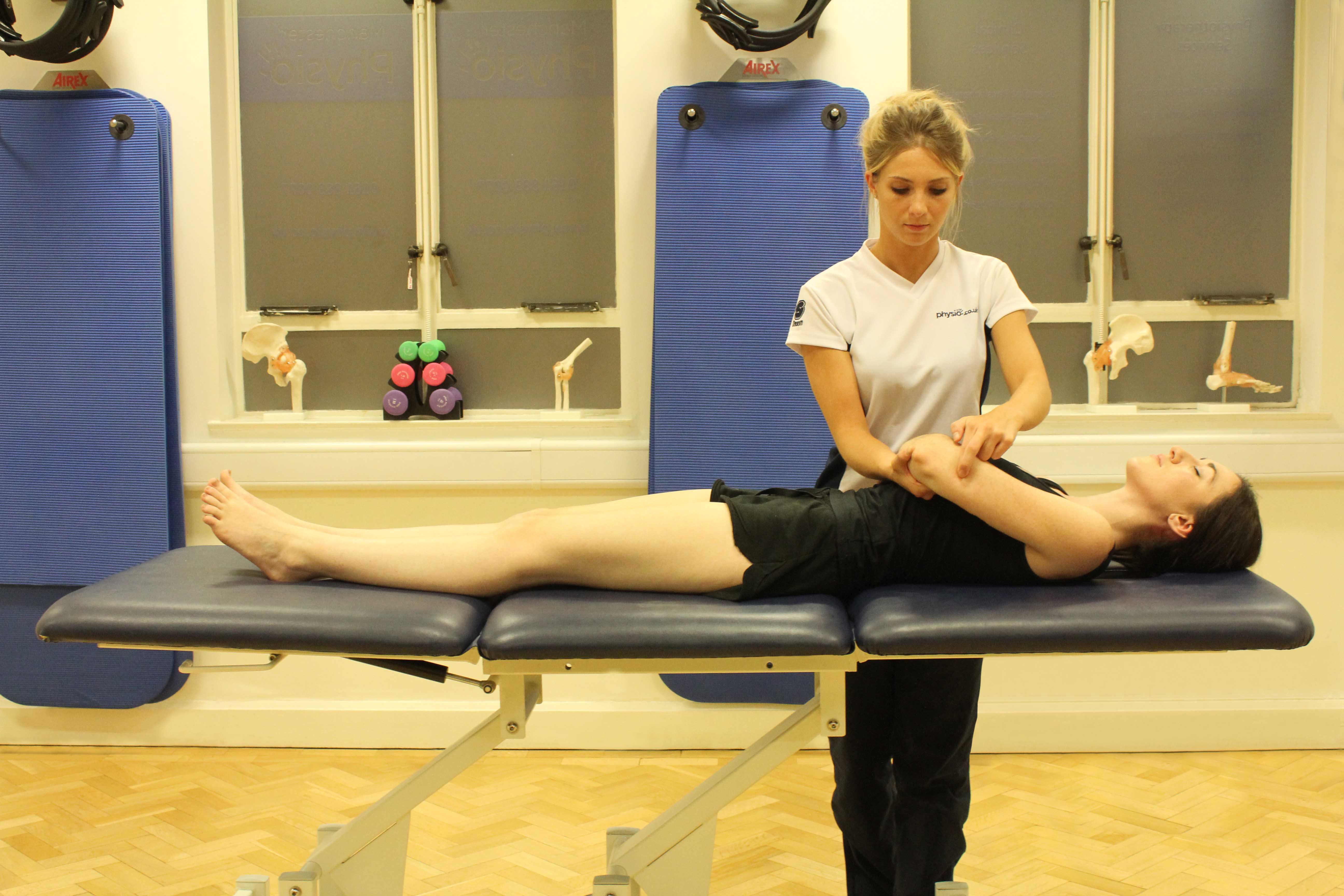What is a posterior dislocation of the elbow joint?
A posterior dislocation of the elbow joint is when a force is applied to the bones that join to make the elbow joint causing them to shift on one another. When this happens the joint surfaces are displaced and, therefore, are no longer in contact. Posterior dislocation of the elbow joint can be treated effectively by physiotherapy programme.
 Above: Friction massage applied to the connective tissues surrounding the elbow
Above: Friction massage applied to the connective tissues surrounding the elbowHow can a posterior dislocation of the elbow joint occur?
The elbow joint can be caused to dislocate when the forces acting on the elbow joint are too great for the supporting muscles and ligaments to resist. This usually requires considerable force and can be caused by a direct impact to the arm such as occurs in contact sports from a fall onto an outstretched hand.
What are the symptoms of a posterior dislocation of the elbow joint?
Immediate and intense pain felt in and around the elbow when it is dislocated. At the time of injury, you may have also sensed something ‘popping out’. This ‘popping out’ or dislocation of the joint is often visible when you compare the injured elbow to the opposite side. Other symptoms include:
What should I do if I have a posterior dislocation of the elbow joint?
A posterior dislocation of the elbow is a serious injury which requires immediate medical attention. When you dislocate your elbow, the artery which supplies blood to the forearm, wrist and hand may also be injured. Damage to this blood vessel can have serious consequences if it is not treated immediately. If you have or suspect you have dislocated your elbow you should go directly to your nearest accident and emergency department. To help with your pain, you can support your arm and apply ice to your elbow. Ideally, this should be in the form of crushed ice wrapped in a moist towel or cloth applied for up to 20 minutes.
At the accident and emergency department they can confirm that the elbow is actually dislocated. If it is, they can assist in relocating or ‘reducing’ the bones back into their normal position and assess whether the artery to forearm, wrist and hand has been damaged. Following this, they can assess whether any other tissues have been damaged and the extent of this damage. An X-ray may be ordered to determine whether any of the bones are damaged. From this, they can provide you with an estimation of how long the injury is expected to take to heal.
Physiotherapy treatment for a posterior dislocation of the elbow joint.
During your recovery, physiotherapy can help reduce your pain and promote your recovery. A sling may have to be worn for the first few weeks. Your physiotherapist can then provide you with a progressive exercise programme designed specifically for you. By increasing your muscle strength and the range of movement at your elbow this programme will increase your chances of making a full recovery and reduce the risk of ongoing elbow problems. Other treatments of benefit include:
What shouldn’t I do if I have a posterior dislocation of the elbow joint?
If you have or suspect that you have dislocated your elbow, the main thing you shouldn’t do is try to ‘reduce’ or relocate the bones back into their normal position. This requires the assistance of a doctor. Serious damage may be done to other structures (arteries, nerves, bones, ligaments, cartilage) if this is performed incorrectly, resulting in irreparable damage and/or a longer recovery time. In addition, you should not undertake any activities which increase blood flow to the injured site, such as hot showers, heat rubs, the consumption of alcohol and massage. These will cause further swelling in the damaged tissues and could prolong your recovery.
Could there be any long-term effects from a posterior dislocation of the elbow joint?
When the elbow joint is dislocated surrounding structures are also commonly registered. The most significant of these is the artery supplying blood to the forearm, wrist and hand. Injury to this artery can cause damage to tissues in the forearm, wrist and hand and reduce the function of your arm. It is also common to overstretch ligaments, compress nerves, break bones and damage the cartilage lining the joint surfaces of the elbow joint if the elbow is dislocated. Injury to these structures can prolong your recovery and result in ongoing elbow problems.
To arrange a physiotherapy asessment call Physio.co.uk on 0330 088 7800 or book online.

 0330 088 7800
0330 088 7800

































